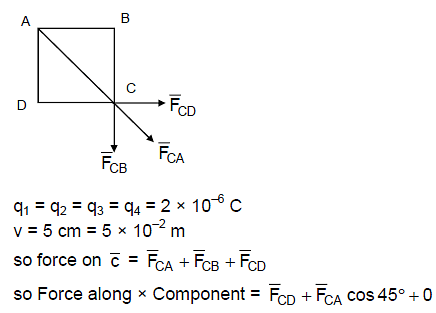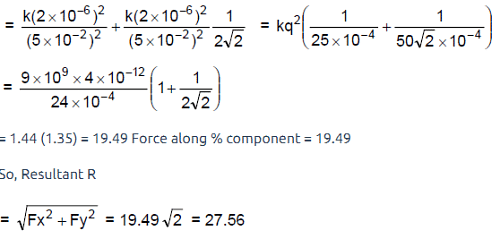JEE Exam > JEE Questions > Four equal charges 2.0×10^(-6) coulomb each a...
Start Learning for Free
Four equal charges 2.0×10^(-6) coulomb each are fixed at the four corner of a square of side 5 cm. find the coulomb force experienced by one of the charges due to the rest three?
Verified Answer
Four equal charges 2.0×10^(-6) coulomb each are fixed at the four corn...


 This question is part of UPSC exam. View all JEE courses
This question is part of UPSC exam. View all JEE courses
Most Upvoted Answer
Four equal charges 2.0×10^(-6) coulomb each are fixed at the four corn...
Four equal charges are fixed at the four corners of a square, and we need to find the Coulomb force experienced by one of the charges due to the rest three. Let's break down the problem step by step.
Step 1: Identifying the given information
- Charges: Four equal charges, each with a magnitude of 2.0×10^(-6) Coulombs.
- Geometry: The charges are fixed at the four corners of a square.
- Side length: The side length of the square is given as 5 cm.
Step 2: Understanding the Coulomb force
The Coulomb force is the electrostatic force of attraction or repulsion between two charged objects. It is given by Coulomb's law:
F = k * (q1 * q2) / r^2
where F is the force, k is the electrostatic constant (9 × 10^9 N m^2/C^2), q1 and q2 are the magnitudes of the charges, and r is the distance between the charges.
Step 3: Determining the distances
Since the charges are fixed at the corners of a square, we can determine the distances between them. The diagonal of a square can be calculated using the Pythagorean theorem:
d = √(s^2 + s^2) = √(2s^2)
where d is the diagonal length and s is the side length of the square. In this case, s = 5 cm, so
d = √(2 * 5^2) = √50 = 5√2 cm
The distance between the charges along the sides of the square is equal to the side length, which is 5 cm.
Step 4: Calculating the Coulomb forces
The force experienced by one charge due to the other charges can be calculated using Coulomb's law. Let's consider one of the charges and calculate the forces due to the other three charges.
Force due to the charge opposite to it:
The charge opposite to the chosen charge is located at a distance of 5√2 cm. Using Coulomb's law:
F1 = (9 × 10^9 N m^2/C^2) * ((2.0×10^(-6) C)^2) / ((5√2 cm)^2)
Simplifying the equation:
F1 = (9 × 10^9 N m^2/C^2) * (4.0×10^(-12) C^2) / (50 cm^2)
Force due to the charges adjacent to it:
The charges adjacent to the chosen charge are located at a distance of 5 cm. Using Coulomb's law:
F2 = (9 × 10^9 N m^2/C^2) * ((2.0×10^(-6) C)^2) / ((5 cm)^2)
Simplifying the equation:
F2 = (9 × 10^9 N m^2/C^2) * (4.0×10^(-12) C^2) / (25 cm^2)
Step 5: Summing up the forces
To find the total force experienced by the chosen charge, we need to sum
Step 1: Identifying the given information
- Charges: Four equal charges, each with a magnitude of 2.0×10^(-6) Coulombs.
- Geometry: The charges are fixed at the four corners of a square.
- Side length: The side length of the square is given as 5 cm.
Step 2: Understanding the Coulomb force
The Coulomb force is the electrostatic force of attraction or repulsion between two charged objects. It is given by Coulomb's law:
F = k * (q1 * q2) / r^2
where F is the force, k is the electrostatic constant (9 × 10^9 N m^2/C^2), q1 and q2 are the magnitudes of the charges, and r is the distance between the charges.
Step 3: Determining the distances
Since the charges are fixed at the corners of a square, we can determine the distances between them. The diagonal of a square can be calculated using the Pythagorean theorem:
d = √(s^2 + s^2) = √(2s^2)
where d is the diagonal length and s is the side length of the square. In this case, s = 5 cm, so
d = √(2 * 5^2) = √50 = 5√2 cm
The distance between the charges along the sides of the square is equal to the side length, which is 5 cm.
Step 4: Calculating the Coulomb forces
The force experienced by one charge due to the other charges can be calculated using Coulomb's law. Let's consider one of the charges and calculate the forces due to the other three charges.
Force due to the charge opposite to it:
The charge opposite to the chosen charge is located at a distance of 5√2 cm. Using Coulomb's law:
F1 = (9 × 10^9 N m^2/C^2) * ((2.0×10^(-6) C)^2) / ((5√2 cm)^2)
Simplifying the equation:
F1 = (9 × 10^9 N m^2/C^2) * (4.0×10^(-12) C^2) / (50 cm^2)
Force due to the charges adjacent to it:
The charges adjacent to the chosen charge are located at a distance of 5 cm. Using Coulomb's law:
F2 = (9 × 10^9 N m^2/C^2) * ((2.0×10^(-6) C)^2) / ((5 cm)^2)
Simplifying the equation:
F2 = (9 × 10^9 N m^2/C^2) * (4.0×10^(-12) C^2) / (25 cm^2)
Step 5: Summing up the forces
To find the total force experienced by the chosen charge, we need to sum
Community Answer
Four equal charges 2.0×10^(-6) coulomb each are fixed at the four corn...
Is the answer 36 N?
Attention JEE Students!
To make sure you are not studying endlessly, EduRev has designed JEE study material, with Structured Courses, Videos, & Test Series. Plus get personalized analysis, doubt solving and improvement plans to achieve a great score in JEE.

|
Explore Courses for JEE exam
|

|
Similar JEE Doubts
Four equal charges 2.0×10^(-6) coulomb each are fixed at the four corner of a square of side 5 cm. find the coulomb force experienced by one of the charges due to the rest three?
Question Description
Four equal charges 2.0×10^(-6) coulomb each are fixed at the four corner of a square of side 5 cm. find the coulomb force experienced by one of the charges due to the rest three? for JEE 2024 is part of JEE preparation. The Question and answers have been prepared according to the JEE exam syllabus. Information about Four equal charges 2.0×10^(-6) coulomb each are fixed at the four corner of a square of side 5 cm. find the coulomb force experienced by one of the charges due to the rest three? covers all topics & solutions for JEE 2024 Exam. Find important definitions, questions, meanings, examples, exercises and tests below for Four equal charges 2.0×10^(-6) coulomb each are fixed at the four corner of a square of side 5 cm. find the coulomb force experienced by one of the charges due to the rest three?.
Four equal charges 2.0×10^(-6) coulomb each are fixed at the four corner of a square of side 5 cm. find the coulomb force experienced by one of the charges due to the rest three? for JEE 2024 is part of JEE preparation. The Question and answers have been prepared according to the JEE exam syllabus. Information about Four equal charges 2.0×10^(-6) coulomb each are fixed at the four corner of a square of side 5 cm. find the coulomb force experienced by one of the charges due to the rest three? covers all topics & solutions for JEE 2024 Exam. Find important definitions, questions, meanings, examples, exercises and tests below for Four equal charges 2.0×10^(-6) coulomb each are fixed at the four corner of a square of side 5 cm. find the coulomb force experienced by one of the charges due to the rest three?.
Solutions for Four equal charges 2.0×10^(-6) coulomb each are fixed at the four corner of a square of side 5 cm. find the coulomb force experienced by one of the charges due to the rest three? in English & in Hindi are available as part of our courses for JEE.
Download more important topics, notes, lectures and mock test series for JEE Exam by signing up for free.
Here you can find the meaning of Four equal charges 2.0×10^(-6) coulomb each are fixed at the four corner of a square of side 5 cm. find the coulomb force experienced by one of the charges due to the rest three? defined & explained in the simplest way possible. Besides giving the explanation of
Four equal charges 2.0×10^(-6) coulomb each are fixed at the four corner of a square of side 5 cm. find the coulomb force experienced by one of the charges due to the rest three?, a detailed solution for Four equal charges 2.0×10^(-6) coulomb each are fixed at the four corner of a square of side 5 cm. find the coulomb force experienced by one of the charges due to the rest three? has been provided alongside types of Four equal charges 2.0×10^(-6) coulomb each are fixed at the four corner of a square of side 5 cm. find the coulomb force experienced by one of the charges due to the rest three? theory, EduRev gives you an
ample number of questions to practice Four equal charges 2.0×10^(-6) coulomb each are fixed at the four corner of a square of side 5 cm. find the coulomb force experienced by one of the charges due to the rest three? tests, examples and also practice JEE tests.

|
Explore Courses for JEE exam
|

|
Suggested Free Tests
Signup for Free!
Signup to see your scores go up within 7 days! Learn & Practice with 1000+ FREE Notes, Videos & Tests.

























